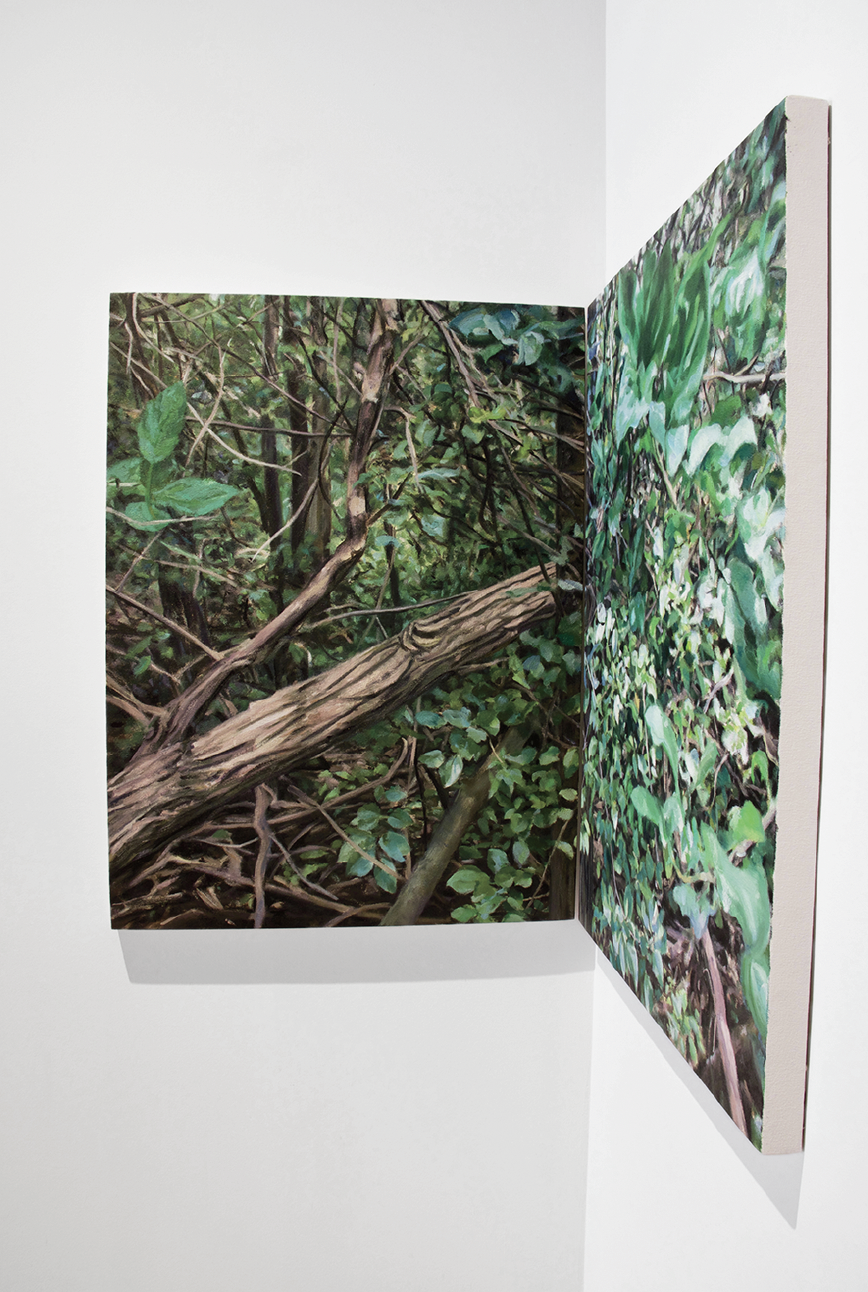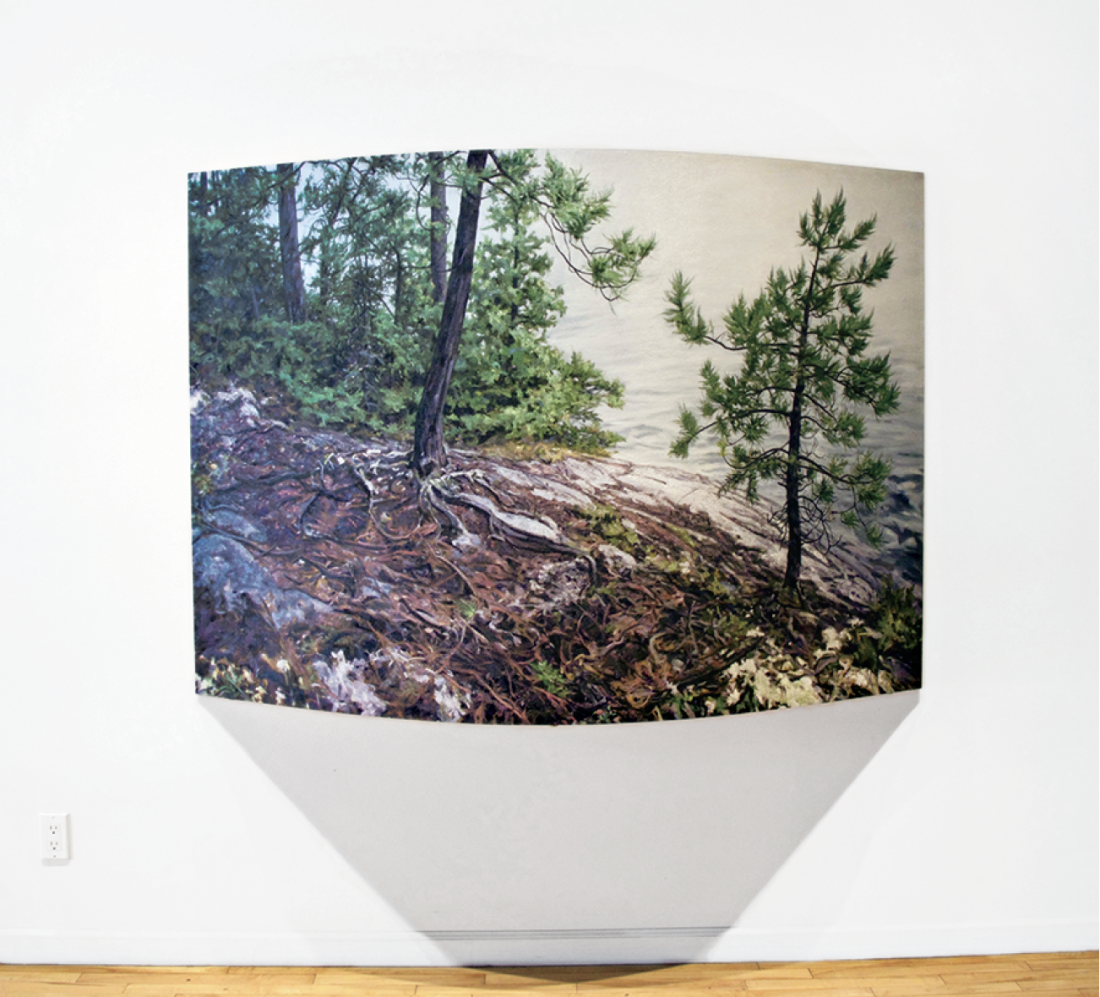Will Gorlitz
At first glance, it may seem that Will Gorlitz loosely continues the tradition of Canadian landscape painting, albeit reinvigorated with contemporary sensibilities, but Gorlitz’s painting practice is not really about the subject matter he paints. Landscape is merely a way into the crux of his work: the visual experience of encountering a painting, in all its observational vigilance and critical thinking glory. “Lie of the Land,” Gorlitz’s first solo exhibition in five years, asks viewers to reflect not only on place, but also placement.
The Michael Gibson Gallery is dedicated to showcasing accomplished regional artists, and this exhibition is no exception. Gorlitz graduated from the University of Manitoba and then completed his Bachelor of Fine Arts at NSCAD, Halifax, in 1977. Now a professor at the University of Guelph, Gorlitz is widely recognized for his painting practice. While he lives and works in Guelph, he has gained a recognition far beyond the southwestern region of Ontario. This stems from major exhibitions since the 1980s, including shows at the Art Gallery of Ontario, the Kitchener Waterloo Art Gallery, the Power Plant, and the Museum of Contemporary Canadian Art, to name a few. Gorlitz’s paintings are also held in collections such as the Musée des beaux-arts de Montréal, the McMichael Canadian Art Collection, the Winnipeg Art Gallery, the Glenbow Museum and the Agnes Etherington Art Centre.

Will Gorlitz, Impasse, 2017, oil on canvas, 36 x 54 inches. All images courtesy Michael Gibson Gallery.
Born in Buenos Aires, Argentina, Gorlitz immigrated with his family to Winnipeg when he was six years old. The artist has cited this personal background as a contributing factor to his fascination with landscape painting. Indeed, the title of the exhibition, “Lie of the Land,” further speaks to this childhood relocation. Arriving someplace new often requires “getting the lie of the land,” but as much as Gorlitz may be referencing a feeling of catching up, viewers engaging with his work undoubtedly get caught on the paintings.
Like a knit sweater that snags on protruding everyday objects, viewers will find themselves mentally snagged on the paintings’ support structures. And there is no question about it—Gorlitz’s technically impressive and distinctly unconventional structures will engage viewers. Whether it’s a convex panel of Masonite, a diptych wedged into a corner or a slightly tapered rectangular canvas, none of Gorlitz’s paintings is ever quite what the viewer has come to expect from painting, being compelled to investigate artworks that demand consideration by virtue of their individual peculiarities. In this exhibition, a viewer doesn’t approach a flat painting hung on the wall; instead, it’s as though the painting were approaching the viewer. Dramatically curved forms barely constrained to the walls require viewers to physically move from side to side to see these convex paintings in their entirety. Small- to medium-sized convex canvases such as Sudden Breeze: Temagami Shoreline initiate visitors as they enter the gallery before moving to larger convex works like Wet Morning: Temagami Shoreline. Arriving at greater consciousness of medium, structure and presentation is vital to fully understanding Gorlitz’s work. He describes his intent in this way: “My own approach is to fundamentally avoid narrative and instead present portals for perceptual encounter that encourage each individual viewer to personally engage in the visual experience as a critical mode of reflection, and hopefully awareness.” The contrived nature of representation is realized by engaging with each painting’s subtle oddities. Presented with the dilemma of unconventional paintings that quietly defy standard expectations, viewers are driven to a state of critical awareness. Small details gnaw at a viewer’s thoughts, slowly prying open minds.

Wet Morning: Temagami Shoreline, 2012–2017, oil on Masonite, 48 x 68 x 13 inches.
As viewers enter the second room, a six-by-four-foot-tall diptych, Late Evening, immediately pulls them in as if with a gravitational force of its own. It is meaningful that the two panels in Late Evening are side by side yet not flush against one another. The placement of the panels draws attention to a slight separation that, again, underlines the support materials and acts as commentary on the tradition of painting itself. Gorlitz literally fragments his paintings while deconstructing or cracking open the very concept of representation. It is precisely this apparent seam, or gap, running up the middle of the work that marks this painting with the artist’s signature thoughtfulness. In a catalogue essay from 2009 on Gorlitz’s work, curator and critic Bruce W Ferguson describes the artist’s paintings as “intellectual paradoxes—even dilemmas—by virtue of being painted to articulate, in a powerful but cautious way, a way of seeing and registering the world more complexly and more ambivalently than is often assumed possible in painting today.” Painting becomes a vehicle of communication for Gorlitz.
And the paintings communicate with one another, too. Gorlitz installs the works so that they are relational, one to the other; that is, the paintings’ placement triggers thoughts based on the sightlines created. Thus, “works of sight become works of site,” as Ferguson pointed out. While examining one painting, the viewer is aware of another in the distance. Continuously “snagging” on works is a kind of resistance manufactured by the artist, but it also leads to discovery on the part of the viewer. Greater cognitive awareness reinforces painting’s artificiality, and ultimately the viewer is grounded in thought. Gorlitz’s resistance to, or questioning of, representation asks viewers to engage critically with his work and with the contemporary condition, which might be understood as the current state where it is necessary to navigate facts and fiction in the onslaught of information available through infinite communication platforms.
Art is deeply entrenched in interpretations and distortions—in the case of this exhibiton, quite literally. Ultimately, meaning is derived from the viewer, and Gorlitz encourages, if not compels, the viewer to critically engage first with his paintings, followed by representation, and then, the greater contemporary condition. In this exhibition, one must expect to be lied to. ❚
“Lie of the Land” was exhibited at Michael Gibson Gallery, London, ON, from May 5 to May 27, 2017.
Carling Spinney recently completed her MA at the University of Western Ontario and currently works as a curatorial assistant at a commercial gallery in Prince Edward County, Ontario.

